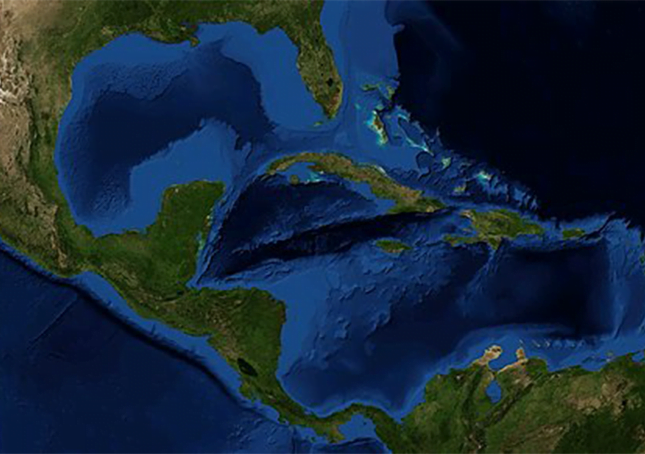Caribbean Sea

The Caribbean Sea (Spanish: Mar Caribe; French: Mer des Caraïbes; Haitian Creole: Lamè Karayib; Jamaican Patois: Kiaribiyan Sii; Dutch: Caraïbische Zee; Papiamento: Laman Karibe) is an American mediterranean sea of the Atlantic Ocean in the tropics of the Western Hemisphere. It is bounded by Mexico and Central America to the west and south west, to the north by the Greater Antilles starting with Cuba, to the east by the Lesser Antilles, and to the south by the north coast of South America.
The entire area of the Caribbean Sea, the numerous islands of the West Indies, and adjacent coasts, are collectively known as the Caribbean. The Caribbean Sea is one of the largest seas and has an area of about 2,754,000 km2 (1,063,000 sq mi). The sea’s deepest point is the Cayman Trough, between the Cayman Islands and Jamaica, at 7,686 m (25,217 ft) below sea level. The Caribbean coastline has many gulfs and bays: the Gulf of Gonâve, Gulf of Venezuela, Gulf of Darién, Golfo de los Mosquitos, Gulf of Paria and Gulf of Honduras.
Coral reef, near Soufrière Quarter, Saint Lucia
The Caribbean Sea has the world’s second largest barrier reef, the Mesoamerican Barrier Reef. It runs 1,000 km (620 mi) along the coasts of Mexico, Belize, Guatemala, and Honduras.
The name “Caribbean” derives from the Caribs, one of the region’s dominant Native American groups at the time of European contact during the late 15th century. After Christopher Columbus landed in the Bahamas in 1492, the Spanish term Antillas applied to the lands; stemming from this, “Sea of the Antilles” became a common alternative name for “Caribbean Sea” in various European languages. During the first century of development, Spanish dominance in the region remained undisputed.
From the 16th century, Europeans visiting the Caribbean region identified the “South Sea” (the Pacific Ocean, to the south of the isthmus of Panama) as opposed to the “North Sea” (the Caribbean Sea, to the north of the same isthmus).
The Caribbean Sea had been unknown to the populations of Eurasia until 1492, when Christopher Columbus sailed into Caribbean waters on a quest to find a sea route to Asia. At that time the Western Hemisphere in general was unknown to most Europeans, although it had been discovered between the years 800 and 1000 by the vikings. Following the discovery of the islands by Columbus, the area was quickly colonized by several Western cultures (initially Spain, then later England, the Dutch Republic, France, Courland and Denmark).
Following the colonization of the Caribbean islands, the Caribbean Sea became a busy area for European-based marine trading and transports, and this commerce eventually attracted pirates such as Samuel Bellamy and Blackbeard.
As of 2015 the area is home to 22 island territories and borders 12 continental countries.
